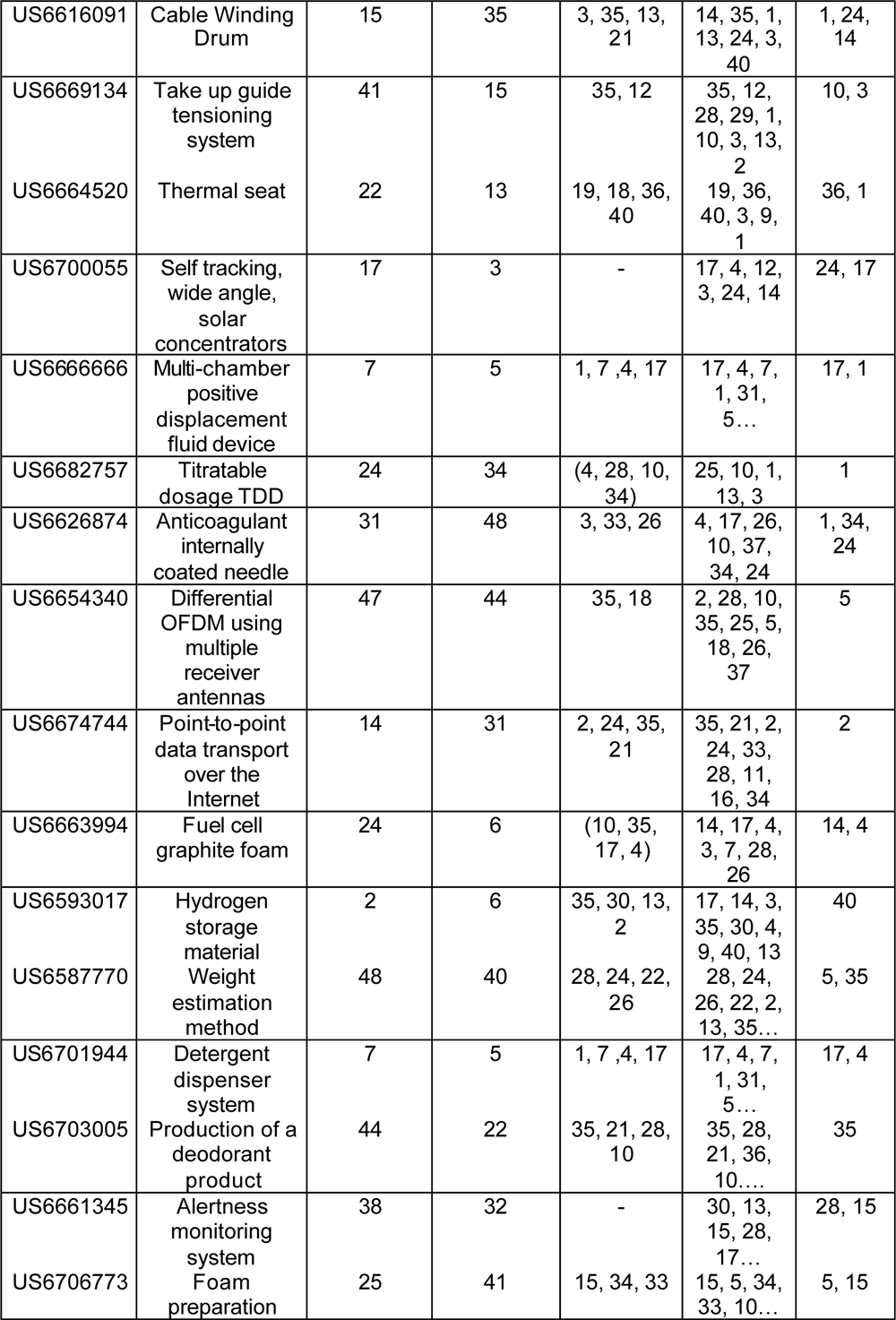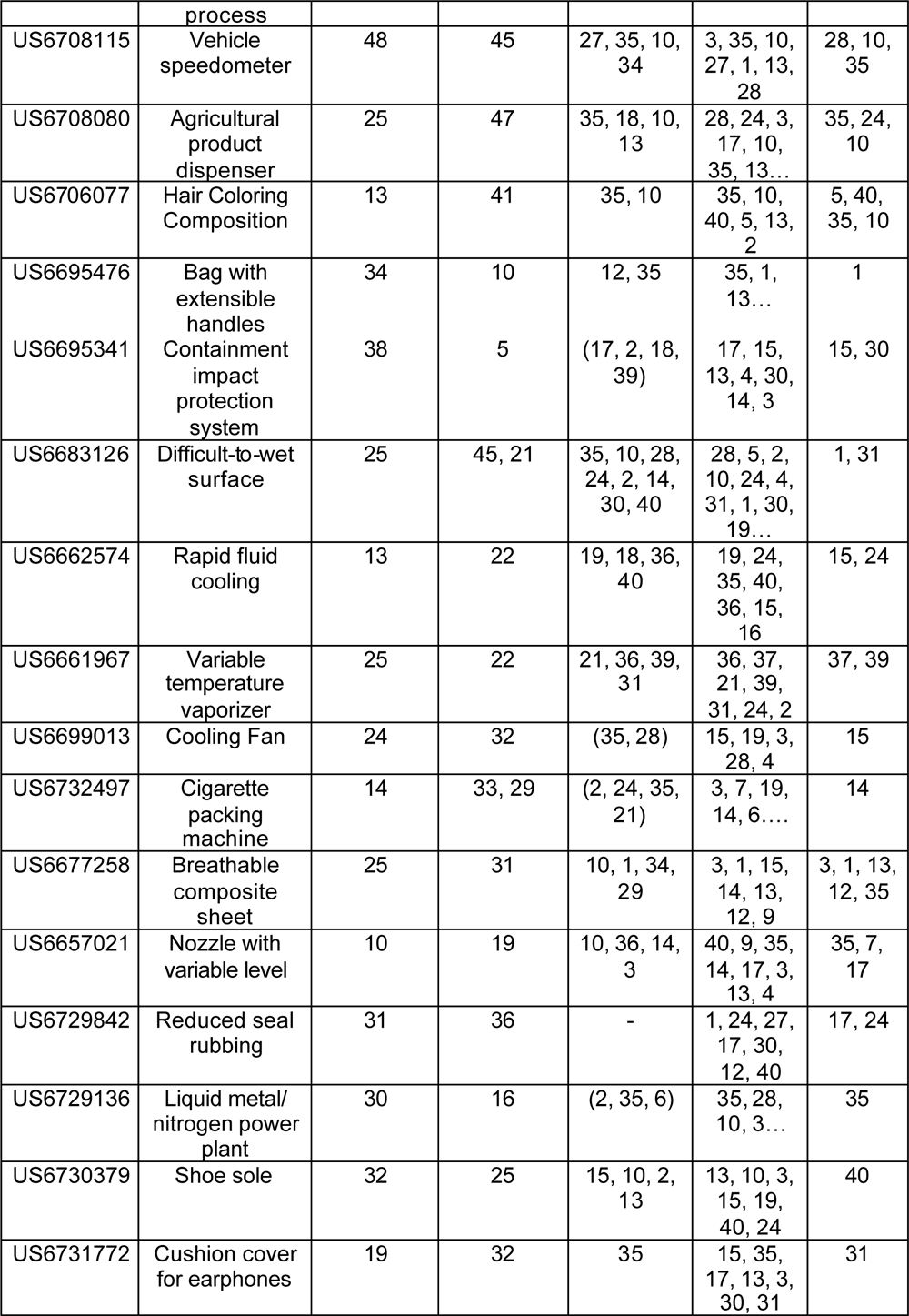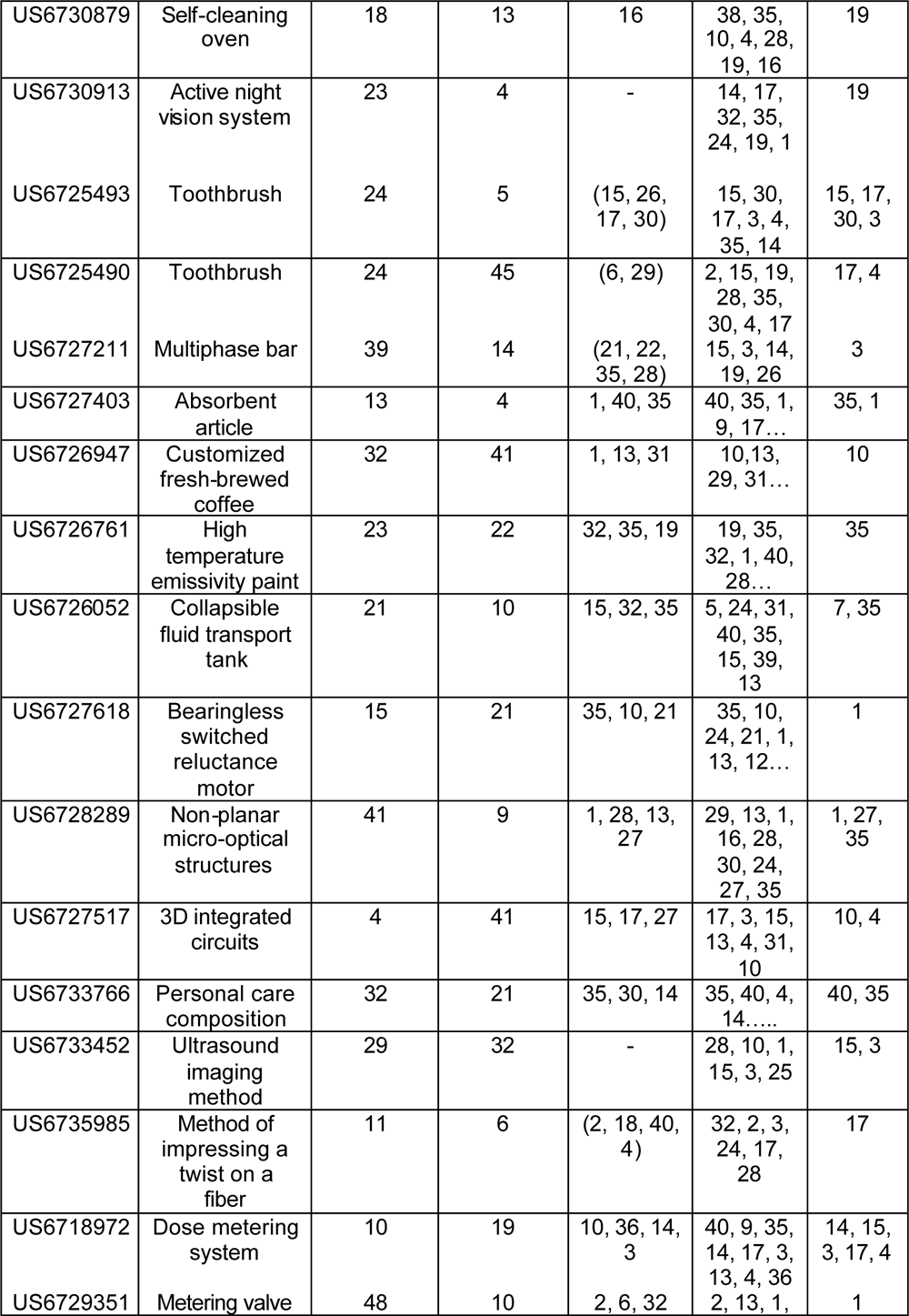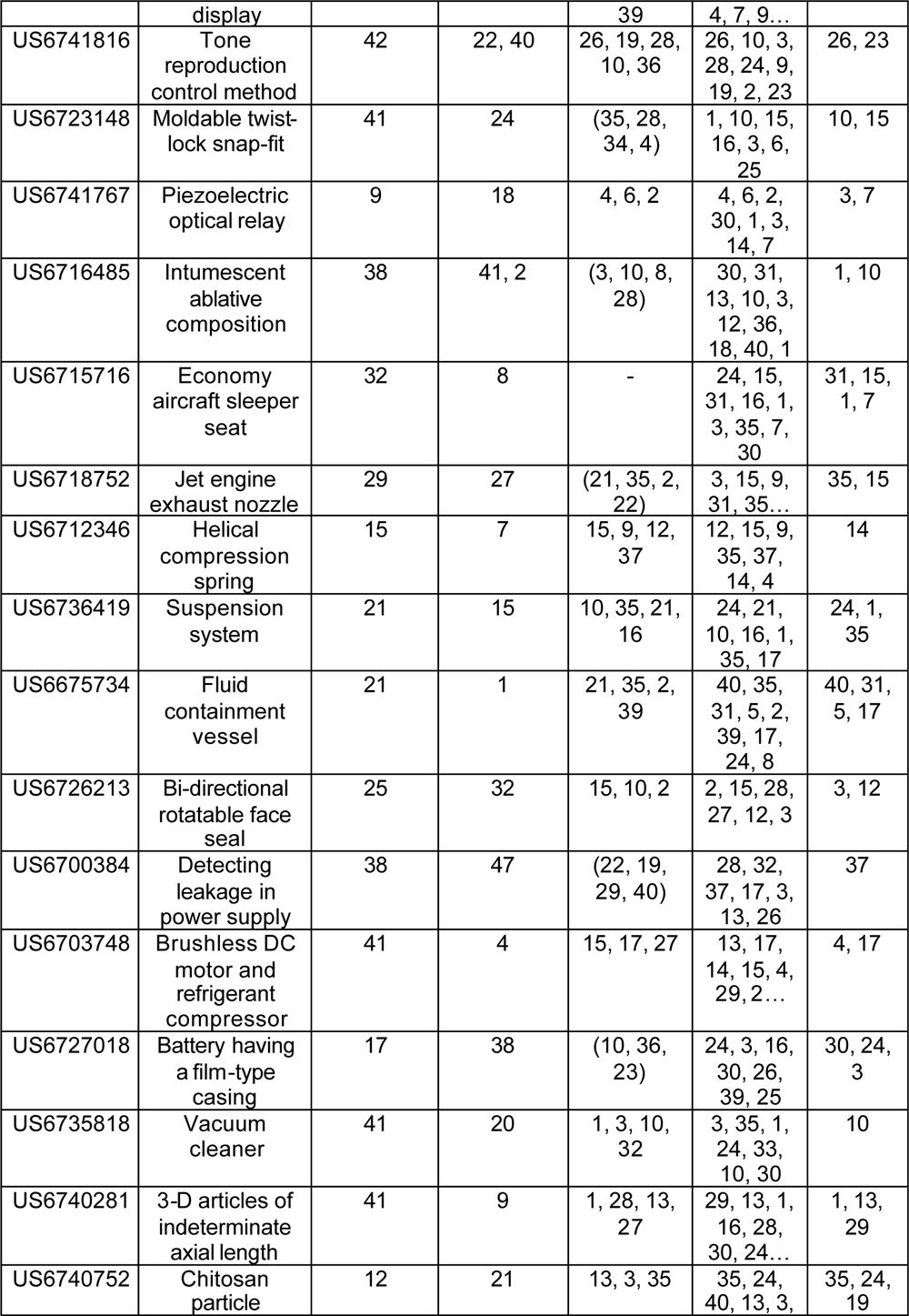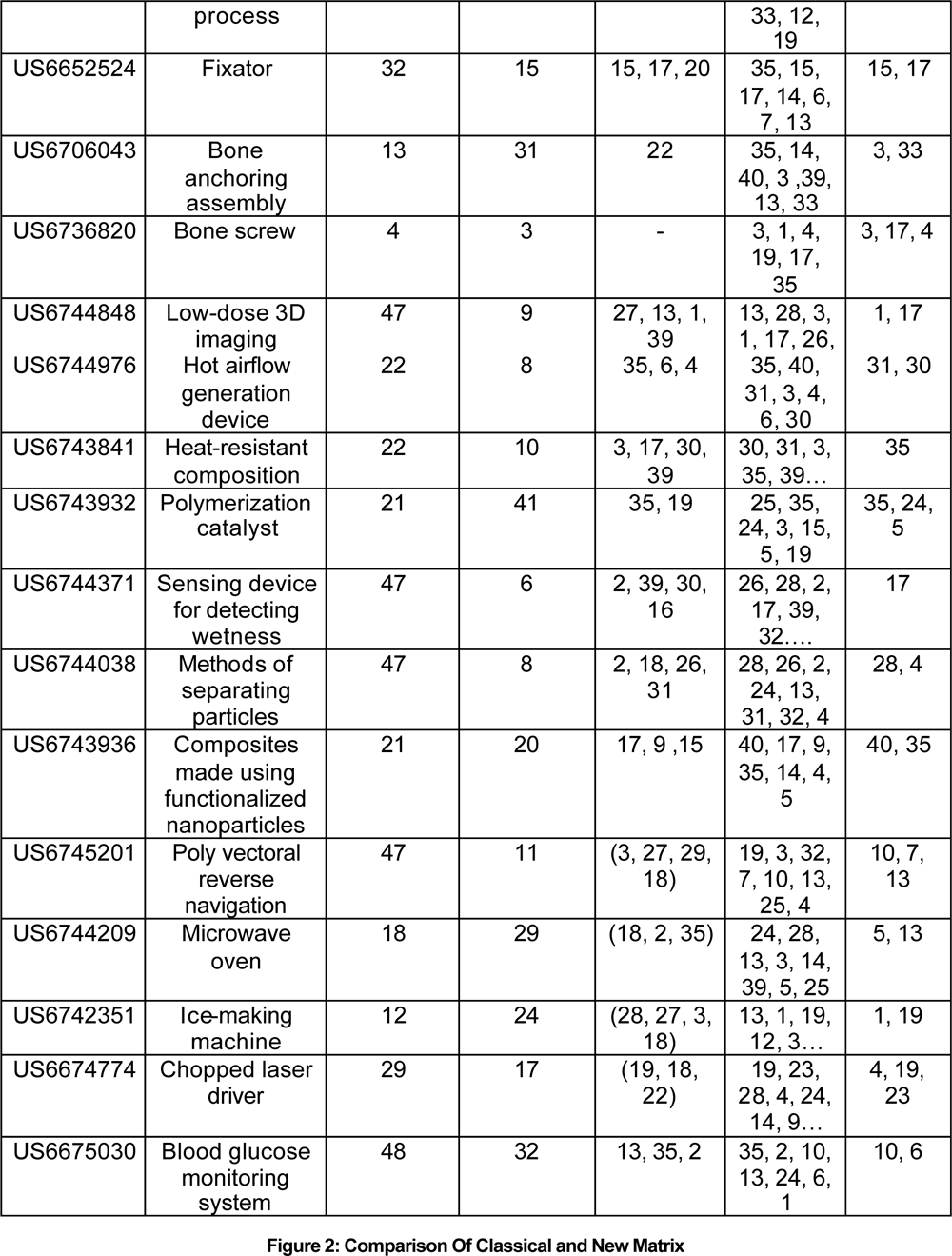Comparing The Classical and New Contradiction Matrix - Part 2- Zooming In
Editor | On 20, Jul 2004
By: Darrell Mann
Director
CREAX
+44 7980 864028
darrell.mann@creax.com
Introduction
This article represents the second of a pair examining the differences between the original Contradiction Matrix of Classical TRIZ (Reference 1) and the 2003 updated version (Reference 2). In this second article, we describe a detailed examination of how the two matrices compare when we analyze patents published since the Matrix 2003 book was completed. The aims are to explore the stability of the new Matrix and to provide quantified data on how well the two matrices predict the Inventive Principles being used by recent inventors.
Method
In keeping with the desire to explore the stability of the new Matrix, it was decided that we needed to make a detailed analysis of patents issued since the publication of the Matrix 2003 book. There are, of course, many published case studies that we could have used as the basis for comparing the original and new matrices. The problem with all of them however, is that their publication date precedes that of the new Matrix, and hence may not be viewed as a fair test. The study reported here, therefore, is based on patents published only after July 2003. The structu re of the work is similar to that reported in a previous piece of work to assess the accuracy of the original Matrix (Reference 3).
A full description of the method can be found in that article. By way of a summary of the method used, the following points will be helpful to readers of this article:
1) a random set of patents from the US patent database has been selected. The only significant selection criterion used has been that the patents should describe an invention that is ‘interesting’ in some form or other – this usually meant a solution featuring some kind of ‘wow’ moment as per the previous, Reference 3, method. Although not a strict definition, this selection criterion effectively meant finding and using mainly Level 3 or 4 inventions as per the original TRIZ definitions. This author made all of the selections in order to ensure consistency. For those familiar with the CREAX newsletter ‘patent of the month’ feature, it was often candidates for this title that were identified and used. Of course, becaus e the patents are so new there has been no means of relating the strength of any given invention to the financial or business success that it offers to the assignees. It is also worth noting that we have tried to select inventions spanning as broad a range of industries as possible. Specifically this has meant searching out interesting patents from materials, electronics/electrical, chemical/pharmaceutical, software, aerospace and fast moving consumer goods.
2) For each patent, we have identified what aspects of a design the inventor was seeking to improve, what parameters these aspects conflicted with, and how the inventor overcame the conflict. With many inventions, of course, the inventor is seeking to overcome a multiplicity of conflicts and contradictions. Rather than try to map all such instances, the analysis here has attempted to identify the one or two most significant aspects of the invention; asking such questions as ‘what was the main motivation of the inventor in terms of the thing they wished to improve?’ and ‘what then was the main thing according to the prior art that prevented that improvement intention from being achieved?’
By way of example, the following is the text from one of the patents analysed:
It is therefore an object of the invention to provide a circuit for driving a laser diode.
It is also an object of the invention to provide a circuit for driving a laser diode which is highly efficient.
It is another object of the invention to provide a circuit for driving a laser diode which has low RF radiation emission.
It is still another object of the invention to provide a circuit for driving a laser diode which is low in cost.
It is yet another object of the invention to provide a circuit for driving a laser diode which has fewer components than conventional circuits.
It is also an object of the invention to provide a circuit for driving a laser diode which does not need to be certified by the FCC.
It is another object of the invention to provide a circuit for driving a laser diode which can be mounted very close to the laser diode.
In this disclosure (actually US6674774, the 99th analysis in the following table of results), we can see that there are several motivating factors behind the invention. In cases like these, the analysis has constructed a hierarchy of factors in order to identify the most significant ones. Thus, in this case, the poor energy usage of the laser generates poor efficiency, which in turn generates heat, which then means that heat management devices have to be fitted and fitting position is restricted, so the cost and complexity goes up. Hence, if the energy usage problem is solved, all of the other problems are also likely to be solved.
With regard to the distillation of Inventive Principles used by an inventor, we have focused on those Principles used to solve the main identified conflict pair. The inventor may have used other Principles to solve other conflicts present in a design, but these have not been recorded here.
Results
The following table summarises the analyses for each of the 100 patents considered during the investigation. In order to ensure consistency of analysis across each patent, this author has monitored each one individually. The table provides patent number, title, improving parameter(s), worsening parameter(s) (both using the numbering convention of the new Matrix – Figure 1), Inventive Principles recommended by the classic Matrix, and Inventive Principles used by the inventor. Anyone wishing to see the specific analysis for any of the patents in question may request a copy from the author. Alternatively, you may like to conduct a few analyses for yourself to see if you agree with the diagnoses presented here.
The new Matrix contains several parameters that are not featured in the classical Matrix. The Inventive Principle suggestions obtained from the original matrix for problems relating to the new parameters (noise, emissions, safety, security, etc) come from the nearest match of parameters in the original list of 39. Where there is no direct match between the conflict challenged by an inventor and the original matrix, the Inventive Principle suggestions are shown in parentheses. A ‘-‘ in the original Matrix recommendations column means that that box contained no recommendations.
Summarised Results
The 100 patents included in the analysis used a total of 206 Inventive Principles. This represents an average of just over 2 Principles per invention.
For the 100 patents included in the analysis, the original Matrix predicted 55 of these Principles. This represents an accuracy rating of just under 27%. This is a rather disappointing result when compared to the rating of almost 50% recorded during the Reference 3 investigation.
The new Matrix identified 198 of the 206 recorded Inventive Principles. This represents an accuracy rating of 96%.
Conclusions
Any attempted validation of a tool conducted by the author of that tool is inevitably going to face criticisms of bias. It would undoubtedly have been preferable if the work had been conducted by a completely independent party. Alas there have thus far been no volunteers to conduct such work. The offer, of course, remains one that is open to all. From the perspective of the author, the objective of the research described here has been to make a genuine attempt to gauge the dynamics of the world of invention. Answers to questions like ‘how often might we need to publish updates to the Matrix?’ have an important impact on the future direction and focus of our research activities. The findings reported here suggest that the Matrix of 2003 is still very good at predicting the inventive steps used by inventors of patents granted in 2004.
The results for the original Matrix are somewhat more disappointing than was anticipated. It is difficult to establish the precise reasons for the poor result. It is possible to suggest that the decision at the beginning of this analysis to select a balance of patents from different disciplines was a contributory factor. This decision meant that the proportion of ‘mechanical’ inventions considered was rather low. The analysis conducted for Reference 3, on the other hand – which obtained a much better result (48% compared to 27% here) – was conducted by mechanical engineers on mechanically focused inventions. Perhaps it is fair to conclude that because the world was a much more ‘mechanical’ place in 1973 when the original Matrix was last updated, it contains an inevitable bias towards mechanical devices, and therefore would understandably be less good at predicting what Principles non-mechanical inventions are likely to use.
References
1) www.the-trizjournal.com July, 1997 and November, 1998. Contradiction Matrix .
2) Mann, D.L., Dewulf, S., Zlotin, B., Zusman, A., ‘Matrix 2003: Updating The TRIZ Contradiction Matrix’, CREAX Press, July 2003.
3) Mann, D.L., ‘Assessing The Accuracy Of The Contradiction Matrix For Recent Mechanical Inventions’, TRIZ Journal, February 2002.




